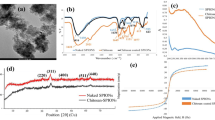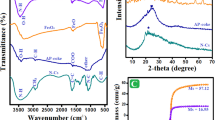Abstract
Water pollution by oil is a serious environmental problem. Develo** new generation of benign adsorbents satisfying several criteria required for real practical application is of great need. This work introduces an effort in this direction, by utilizing a facile synthesis of wood sawdust coated magnetite nanoparticles functionalized stearic acid (WSD@Fe3O4NPs/SA) as a novel nano composite along with its precursor WSD@Fe3O4NPs. SA was covalently bonded to the precursor by amide bond formation via the interaction with the silylating agent 3-aminopropyltrimethoxysilane (3-APTS). This mode of binding is more stronger than the conventional ester bond. Fourier transform infrared (FT-IR), X- ray powder diffraction (XRD), Scanning electron microscope (SEM) and Transmittance electron microscope (TEM) were employed for characterization and follow up the synthesis process. Application of the newly synthesized magnetic nano composite adsorbent under optimized parameters of contact time (min) and composite dosage (g) reveal high removal capacity values (g/g) evaluated to be 28.32 g/g, 5 min and 0.1 g for used motor oil removal and 41.22 g/g, 10 min and 0.1 g for crude oil. The high removal efficiency exhibited by WSD@Fe3O4NPs/SA was mainly argued to the long hydrocarbon chain of SA moiety and additional ـــ (CH2)3 ـــ groups incorporated 3-ATPS. Moreover, Analysis of the oil adsorption experimental equilibrium data were well fitted with Freundlish model with correlation coefficients r2 = 0.9788 and 0.9896 for used motor oil and crude oil, respectively. The kinetic data were correlated using two kinetic models and the results were in harmony with pseudo-second order.












Similar content being viewed by others
References
Uncategorized references
Wei QF, Mather RR, Fotheringham AF, Yang RD. Evaluation of nonwoven polypropylene oil sorbents in marine oil-spill recovery. Mar Pollut Bull. 2003;46(6):780–3. https://doi.org/10.1016/S0025-326X(03)00042-0.
Fathy M, El-Sayed M, Ramzi M, Abdelraheem OH. Adsorption separation of condensate oil from produced water using ACTF prepared of oil palm leaves by batch and fixed bed techniques. Egypt J Pet. 2018;27(3):319–26. https://doi.org/10.1016/j.ejpe.2017.05.005.
Abbasi Monfared M, Sheikhi M, Kasiri N, Mohammadi T. Experimental investigation of oil-in-water microfiltration assisted by Dielectrophoresis: operational condition optimization. Chem Eng Res Des. 2018;137:421–33. https://doi.org/10.1016/j.cherd.2018.08.002.
Fredriksen SB, Rognmo AU, Fernø MA. Pore-scale mechanisms during low salinity waterflooding: oil mobilization by diffusion and osmosis. J Pet Sci Eng. 2018;163:650–60. https://doi.org/10.1016/j.petrol.2017.10.022.
Abdelwahab NA, Abd El-Ghaffar MA. Preparation and characterization of highly hydrophobic magnetic polyaniline nanocomposite for fast and efficient separation of diesel oil from seawater. Mater Res Bull. 2016;84:7–14. https://doi.org/10.1016/j.materresbull.2016.07.022.
Adebajo MO, Frost RL, Kloprogge JT, Carmody O, Kokot S. Porous materials for oil spill cleanup: a review of synthesis and absorbing properties. J Porous Mater. 2003;10(3):159–70. https://doi.org/10.1023/A:1027484117065.
Nakazawa M, Somorjai GA. Coadsorption of water and selected aromatic molecules to model the adhesion of epoxy resins on hydrated surfaces of zinc oxide and iron oxide. Appl Surf Sci. 1995;84(3):309–23. https://doi.org/10.1016/0169-4332(94)00537-0.
Gao G-M, Liu D-R, Zou H-F, Zou L-C, Gan S-C. Preparation of silica aerogel from oil shale ash by fluidized bed drying. Powder Technol. 2010;197(3):283–7. https://doi.org/10.1016/j.powtec.2009.10.005.
Nassar MY, Abdelrahman EA, Aly AA, Mohamed TY. A facile synthesis of mordenite zeolite nanostructures for efficient bleaching of crude soybean oil and removal of methylene blue dye from aqueous media. J Mol Liq. 2017;248:302–13. https://doi.org/10.1016/j.molliq.2017.10.061.
Ugochukwu UC, Fialips CI. Crude oil polycyclic aromatic hydrocarbons removal via clay-microbe-oil interactions: effect of acid activated clay minerals. Chemosphere. 2017;178:65–72. https://doi.org/10.1016/j.chemosphere.2017.03.035.
Takeuchi K, Kitazawa H, Fujishige M, Akuzawa N, Ortiz-Medina J, Morelos-Gomez A, et al. Oil removing properties of exfoliated graphite in actual produced water treatment. Journal of Water Process Engineering. 2017;20:226–31. https://doi.org/10.1016/j.jwpe.2017.11.009.
Peng Y, Yu Z, Li F, Chen Q, Yin D, Min X. A novel reduced graphene oxide-based composite membrane prepared via a facile deposition method for multifunctional applications: oil/water separation and cationic dyes removal. Sep Purif Technol. 2018;200:130–40. https://doi.org/10.1016/j.seppur.2018.01.059.
Shaheen HA, Marwani HM, Soliman EM. Selective adsorption of gold ions from complex system using oxidized multi-walled carbon nanotubes. J Mol Liq. 2015;212:480–6. https://doi.org/10.1016/j.molliq.2015.09.040.
Chin SF, Binti Romainor AN, Pang SC. Fabrication of hydrophobic and magnetic cellulose aerogel with high oil absorption capacity. Mater Lett. 2014;115:241–3. https://doi.org/10.1016/j.matlet.2013.10.061.
Raj KG, Joy PA. Coconut shell based activated carbon–iron oxide magnetic nanocomposite for fast and efficient removal of oil spills. Journal of Environmental Chemical Engineering. 2015;3(3):2068–75. https://doi.org/10.1016/j.jece.2015.04.028.
Merkel TC, Freeman BD, Spontak RJ, He Z, Pinnau I, Meakin P, et al. Ultrapermeable. Reverse-Selective Nanocomposite Membranes Science. 2002;296(5567):519–22. https://doi.org/10.1126/science.1069580.
Gupta S, He W-D, Tai N-H. A comparative study on superhydrophobic sponges and their application as fluid channel for continuous separation of oils and organic solvents from water. Compos Part B. 2016;101:99–106. https://doi.org/10.1016/j.compositesb.2016.06.002.
Yu L, Hao G, Liang Q, Zhou S, Zhang N, Jiang W. Facile preparation and characterization of modified magnetic silica nanocomposite particles for oil absorption. Applied Surface Science. 2015;357, Part B:2297–305. https://doi.org/10.1016/j.apsusc.2015.09.231.
Zang D, Liu F, Zhang M, Gao Z, Wang C. Novel superhydrophobic and superoleophilic sawdust as a selective oil sorbent for oil spill cleanup. Chem Eng Res Des. 2015;102:34–41. https://doi.org/10.1016/j.cherd.2015.06.014.
Banerjee SS, Joshi MV, Jayaram RV. Treatment of oil spill by sorption technique using fatty acid grafted sawdust. Chemosphere. 2006;64(6):1026–31. https://doi.org/10.1016/j.chemosphere.2006.01.065.
Lanigan RM, Sheppard TD. Recent developments in amide synthesis: direct amidation of carboxylic acids and transamidation reactions. Eur J Org Chem. 2013;2013(33):7453–65.
Kumar R, Barakat M, Soliman EM. Removal of tannic acid from aqueous solution by magnetic carbohydrate natural polymer. J Ind Eng Chem. 2014;20(5):2992–7.
Yamaura M, Camilo RL, Sampaio LC, Macêdo MA, Nakamura M, Toma HE. Preparation and characterization of (3-aminopropyl)triethoxysilane-coated magnetite nanoparticles. J Magn Magn Mater. 2004;279(2):210–7. https://doi.org/10.1016/j.jmmm.2004.01.094.
Ahmed SA, Soliman EM. Silica coated magnetic particles using microwave synthesis for removal of dyes from natural water samples: synthesis, characterization, equilibrium, isotherm and kinetics studies. Appl Surf Sci. 2013;284:23–32. https://doi.org/10.1016/j.apsusc.2013.06.129.
Gan W, Gao L, Zhang W, Li J, Cai L, Zhan X. Removal of oils from water surface via useful recyclable CoFe2O4/sawdust composites under magnetic field. Mater Des. 2016;98:194–200. https://doi.org/10.1016/j.matdes.2016.03.018.
Di X, Zhang W, Jiang Z, Zhang M, Wang Y, Liu F, et al. Facile and rapid separation of oil from emulsions by hydrophobic and lipophilic Fe3O4/sawdust composites. Chem Eng Res Des. 2018;129:102–10. https://doi.org/10.1016/j.cherd.2017.10.025.
Lange's Handbook of chemistry. 7th ed. edited by norbert Adolph Lange. Handbook Publishers, Sandusky, Ohio, 1949. xvi + 1920pp. 13 × 20cm. Price $ 7. Journal of the American Pharmaceutical Association (Scientific ed). 1949;38(12):667. https://doi.org/10.1002/jps.3030381240.
Girginova PI, Daniel-da-Silva AL, Lopes CB, Figueira P, Otero M, Amaral VS, et al. Silica coated magnetite particles for magnetic removal of Hg2+ from water. J Colloid Interface Sci. 2010;345(2):234–40. https://doi.org/10.1016/j.jcis.2010.01.087.
P-s Q, Lin N, Y-z L, J-j Z. Improvement of oil/water selectivity by stearic acid modified expanded perlite for oil spill cleanup. Journal of Shanghai Jiaotong University (Science). 2013;18(4):500–7.
Soliman EM, Marwani HM, Albishri HM. Novel solid-phase extractor based on functionalization of multi-walled carbon nano tubes with 5-aminosalicylic acid for preconcentration of Pb (II) in water samples prior to determination by ICP-OES. Environ Monit Assess. 2013;185(12):10269–80.
Fan P, Yuan Y, Ren J, Yuan B, He Q, **a G, et al. Facile and green fabrication of cellulosed based aerogels for lampblack filtration from waste newspaper. Carbohydr Polym. 2017;162:108–14. https://doi.org/10.1016/j.carbpol.2017.01.015.
Fan L, Zhang Y, Li X, Luo C, Lu F, Qiu H. Removal of alizarin red from water environment using magnetic chitosan with alizarin red as imprinted molecules. Colloids Surf B: Biointerfaces. 2012;91:250–7. https://doi.org/10.1016/j.colsurfb.2011.11.014.
Fu X, Chen X, Wang J, Liu J. Fabrication of carboxylic functionalized superparamagnetic mesoporous silica microspheres and their application for removal basic dye pollutants from water. Microporous Mesoporous Mater. 2011;139(1):8–15. https://doi.org/10.1016/j.micromeso.2010.10.004.
Prinsen P, Luque R, González-Arellano C. Zeolite catalyzed palmitic acid esterification. Microporous Mesoporous Mater. 2018;262:133–9. https://doi.org/10.1016/j.micromeso.2017.11.029.
Wang Y-T, Fang Z, Zhang F. Esterification of oleic acid to biodiesel catalyzed by a highly acidic carbonaceous catalyst. Catal Today. 2018. https://doi.org/10.1016/j.cattod.2018.06.041.
Keyhanian F, Shariati S, Faraji M, Hesabi M. Magnetite nanoparticles with surface modification for removal of methyl violet from aqueous solutions. Arab J Chem. 2016;9:S348–S54. https://doi.org/10.1016/j.arabjc.2011.04.012.
Gan W, Gao L, Zhang W, Li J, Zhan X. Fabrication of microwave absorbing CoFe2O4 coatings with robust superhydrophobicity on natural wood surfaces. Ceram Int. 2016;42(11):13199–206. https://doi.org/10.1016/j.ceramint.2016.05.112.
Li J, Luo M, Zhao C-J, Li C-Y, Wang W, Zu Y-G, et al. Oil removal from water with yellow horn shell residues treated by ionic liquid. Bioresour Technol. 2013;128:673–8. https://doi.org/10.1016/j.biortech.2012.11.009.
Yu L, Hao G, Gu J, Zhou S, Zhang N, Jiang W. Fe3O4/PS magnetic nanoparticles: synthesis, characterization and their application as sorbents of oil from waste water. J Magn Magn Mater. 2015;394:14–21. https://doi.org/10.1016/j.jmmm.2015.06.045.
Radetic M, Ilic V, Radojevic D, Miladinovic R, Jocic D, Jovancic P. Efficiency of recycled wool-based nonwoven material for the removal of oils from water. Chemosphere. 2008;70(3):525–30. https://doi.org/10.1016/j.chemosphere.2007.07.005.
Shiu R-F, Lee C-L, Hsieh P-Y, Chen C-S, Kang Y-Y, Chin W-C, et al. Superhydrophobic graphene-based sponge as a novel sorbent for crude oil removal under various environmental conditions. Chemosphere. 2018;207:110–7. https://doi.org/10.1016/j.chemosphere.2018.05.071.
Vlaev L, Petkov P, Dimitrov A, Genieva S. Cleanup of water polluted with crude oil or diesel fuel using rice husks ash. J Taiwan Inst Chem Eng. 2011;42(6):957–64. https://doi.org/10.1016/j.jtice.2011.04.004.
Al Zubaidi IAH, Al Tamimi AK, Ahmed H. Remediation of water from crude oil spill using a fibrous sorbent. Environmental Technology & Innovation. 2016;6:105–14. https://doi.org/10.1016/j.eti.2016.08.002.
Ye X, Cui Y, Ke L, Gao K, Huang X, Shi B. Fabrication of 3D porous superhydrophobic sponges using plant polyphenol-Fe3+ complexes as adhesive and their applications in oil/water separation. Colloids Surf A Physicochem Eng Asp. 2018;551:9–16. https://doi.org/10.1016/j.colsurfa.2018.04.053.
Wang J, Zheng Y, Wang A. Investigation of acetylated kapok fibers on the sorption of oil in water. J Environ Sci. 2013;25(2):246–53. https://doi.org/10.1016/S1001-0742(12)60031-X.
Gui X, Li H, Wang K, Wei J, Jia Y, Li Z, et al. Recyclable carbon nanotube sponges for oil absorption. Acta Mater. 2011;59(12):4798–804. https://doi.org/10.1016/j.actamat.2011.04.022.
Ahmed SA, Soliman EM. New trend for acceleration solid phase extraction process based on using magnetic Nano-adsorbents along with surface functionalization through microwave assisted solvent-free technique. Anal Sci. 2015;31(10):1047–54.
Author information
Authors and Affiliations
Corresponding author
Additional information
Publisher’s note
Springer Nature remains neutral with regard to jurisdictional claims in published maps and institutional affiliations.
Rights and permissions
About this article
Cite this article
Soliman, E.M., Ahmed, S.A. & Fadl, A.A. Adsorptive removal of oil spill from sea water surface using magnetic wood sawdust as a novel nano-composite synthesized via microwave approach. J Environ Health Sci Engineer 18, 79–90 (2020). https://doi.org/10.1007/s40201-019-00440-4
Received:
Accepted:
Published:
Issue Date:
DOI: https://doi.org/10.1007/s40201-019-00440-4




